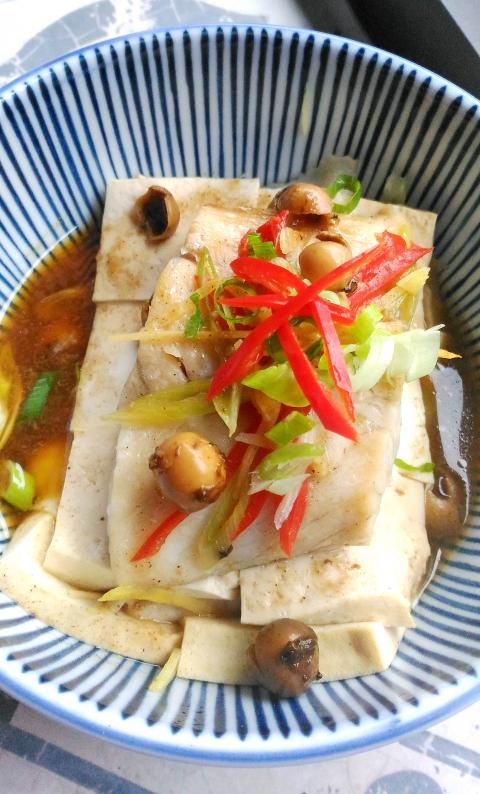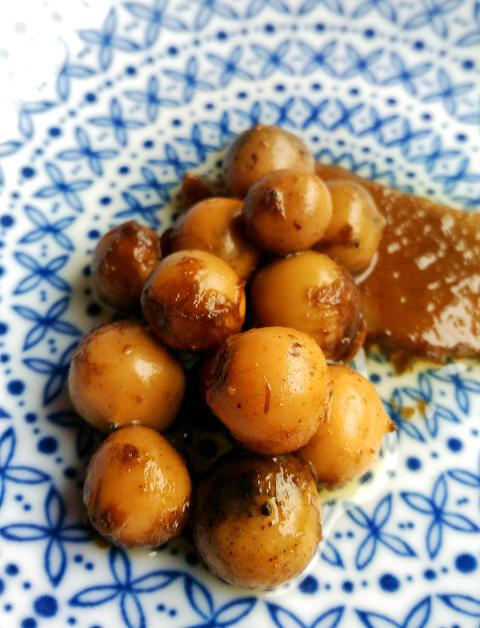Some plants are just unlucky in their names, and it is for this reason that cordia dichotoma may not have achieved great popularity in the kitchen, at least in the West. The scientific name is not particularly memorable, and its common names, which include “snotty gobbles” and “glue berry” are downright off putting. But cordia dichotoma is a valuable addition to the pantry and in its pickled form is widely available in Taiwan.
In Taiwan, cordia dichotoma is best known by the vernacular name pobuzi (破布子) and is most often found as a garnish to fish dishes. It often fulfills a function similar to that of capers in European cooking, with a slightly sour flavor that works particularly well with white-fleshed fish.
Cordia dichotoma is harvested around July. It has a short fruiting season and does not keep well, so it is most often preserved, sometimes by cooking and pressing into cakes or soaked a light brine, sometimes with the addition of ginger or other spices. In the former case it is sometimes already deseeded, but in the latter it usually comes with the seed.

Photo: Ian Bartholomew
The harvesting of cordia dichotoma is labor intensive and while the fruit can be used directly in cooking, I have yet to taste it this way in Taiwan. It is used fresh in Indian cooking, and may be known by its Hindi name gunda.
While the seed helps preserve the shape of the fruit, making it look more appealing on the plate, it does not allow the berry to reveal its full flavor. My own first acquaintance with it was in restaurant dishes when the berries are scattered atop a dish of steamed whole fish. The berries, which are small, generally get left behind on the plate as the tiny berries with their even smaller pips are not easy to handle when one is trying to feed oneself with some semblance of elegance. This is rather a pity, as the flesh of the cordia dichotoma is quite tasty and it also has various health benefits. In Chinese medical lore, it is regarded as a useful anti-inflammatory and also is said to help with the symptoms of high blood pressure.
When using cordia dichotoma it is recommended that the seeds be removed before the berry is incorporated into your food. An easy way to do this is to place a quantity of the berries into a small bag of muslin cloth and simply press down, pinching a little with the fingers. The flesh of the fruit will readily separate from the seed, which then can be easily picked out.

Photo: Ian Bartholomew
In addition to its usual pairing with fish, cordia dichotoma can also be used to particular advantage with tofu and some vegetables. Seeded cordia dichotoma can be mashed together with tofu to make a kind of savory pudding that is very nutritious and goes very well with warm white rice, and it can be incorporated into dishes such as stir fried bird’s nest fern, replacing the ubiquitous dried whitebait. At its simplest, it is sometimes simply fried and used as a garnish for a bowl of rice porridge.
Steamed fish and tofu with cordia dichotoma
Recipe
(serves two)
This is a really simple dish that can be put together in a matter of minutes with little fuss. The fish and cordia dichotoma give the tofu a lovely, subtle flavor and it is a perfect dish for times when you might be feeling a bit delicate.
Ingredients
200g sea bass fillets (or other fine-grained white fish)
200g firm tofu
About 10 berries of cordia dichotoma, seeds removed and minced
1 stem spring onion, julienned
1 nub ginger, finely julienned
1 chili, seeds removed and finely sliced
1 tbsp light soy
1 tsp sesame oil
White pepper
Salt
Directions
1. About 15 minutes before cooking, clean and slice the fish fillets and season with salt. Set aside.
2. Cut tofu into 1cm thick slices.
3. In a bowl, place a layer of tofu at the base. Sprinkle with minced cordia dichotoma.
4. Place a layer of fish, a bit more cordia dichotoma, then another layer of tofu. Three layers of each should be sufficient.
5. Drizzle with soy and sesame oil. Add white pepper and top with the ginger, spring onion and chili.
6. Bring a pot to a boil and place a steaming basket over it. Steam for 10 to 15 minutes with the cover on. Serve with white rice.
Ian Bartholomew runs Ian’s Table, a small guesthouse in Hualien. He has lived in Taiwan for many years writing about the food scene and has decided that until you look at farming, you know nothing about the food you eat. He can be contacted at Hualien202@gmail.com.

Following the shock complete failure of all the recall votes against Chinese Nationalist Party (KMT) lawmakers on July 26, pan-blue supporters and the Chinese Communist Party (CCP) were giddy with victory. A notable exception was KMT Chairman Eric Chu (朱立倫), who knew better. At a press conference on July 29, he bowed deeply in gratitude to the voters and said the recalls were “not about which party won or lost, but were a great victory for the Taiwanese voters.” The entire recall process was a disaster for both the KMT and the Democratic Progressive Party (DPP). The only bright spot for

As last month dawned, the Democratic Progressive Party (DPP) was in a good position. The recall campaigns had strong momentum, polling showed many Chinese Nationalist Party (KMT) lawmakers at risk of recall and even the KMT was bracing for losing seats while facing a tsunami of voter fraud investigations. Polling pointed to some of the recalls being a lock for victory. Though in most districts the majority was against recalling their lawmaker, among voters “definitely” planning to vote, there were double-digit margins in favor of recall in at least five districts, with three districts near or above 20 percent in

From Godzilla’s fiery atomic breath to post-apocalyptic anime and harrowing depictions of radiation sickness, the influence of the nuclear bombings of Hiroshima and Nagasaki runs deep in Japanese popular culture. In the 80 years since the World War II attacks, stories of destruction and mutation have been fused with fears around natural disasters and, more recently, the Fukushima crisis. Classic manga and anime series Astro Boy is called “Mighty Atom” in Japanese, while city-leveling explosions loom large in other titles such as Akira, Neon Genesis Evangelion and Attack on Titan. “Living through tremendous pain” and overcoming trauma is a recurrent theme in Japan’s

The great number of islands that make up the Penghu archipelago make it a fascinating place to come back and explore again and again. On your next trip to Penghu, why not get off the beaten path and explore a lesser-traveled outlying island? Jibei Island (吉貝嶼) in Baisha Township (白沙鄉) is a popular destination for its long white sand beach and water activities. However, three other permanently inhabited islands in the township put a unique spin on the traditional Penghu charm, making them great destinations for the curious tourist: Yuanbeiyu (員貝嶼), Niaoyu (鳥嶼) and Dacangyu (大倉嶼). YUANBEIYU Citou Wharf (岐頭碼頭) connects the mainland